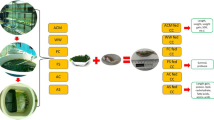Abstract
Abalone production in Korea has reached 5000 metric tonnes (MT) since 2000 and has been consistently increasing to reach 10,000 MT in 2015. Abalone fisheries are mainly seen in Wando on the south coast of Korea, where seaweed aquaculture has been majorly conducted. Mass mortality of abalone spats is considered a major problem in abalone fisheries and is caused by changes in environmental factors and food availability (including availability of benthic diatoms). However, it is difficult to supply sufficient quantities of benthic diatoms to post-larvae abalone. Therefore, we explored the development of growth-promoting substances for diatoms Navicula sp. and experimentally mixed several substances to enhance the growth of diatoms. In this study, we used alginic acid, fucoidan, Scytosiphon lomentaria, Ecklonia cava, Ecklonia cava processing byproduct (i.e., Ecklonia cava–boiled extracts, EBE), and Porphyra tenera. In addition, EBE, phosphate fertilizer (PF), nitrogenous manure (NM), and sodium silicate (SS) were mixed to determine the optimal composition of growth substances. The growth of diatoms significantly increased under EBE exposure, compared with other substances. During this study, attempts were made to identify the optimal composition of mixtures of PF, NM, and SS with that of EBE (1:1:1:1). The Navicula sp. growth-promoting substance (NGPS) mixture enhanced Navicula sp. growth by 150% compared with existing market products. We were therefore able to develop a substance that promotes the growth of diatoms, thereby facilitating the cultivation of healthy abalone with reduced mortality.







Similar content being viewed by others
References
Watson D, Daume S, Prince J, Beazley L, Knott B (2004a) The influence of light intensity on the density of different diatoms as feed for juvenile greenlip abalone (Haliotis laevigata). Aquaculture 235:345–359
Mercer JP, Mai K-S, Donlon J (1993) Comparative studies on the nutrition of two species of abalone, Haliotis tuberculata Linnaeus and Haliotis duscus hannai Ino I. Effects of algal diets on growth and biochemical composition. Invertebr Reprod Dev 23(2-3):75–88
Han HK, Hur SB (2000a) Dietary value of benthic diatoms for newly settled abalone, Haliotis discus hannami Ino. Aquaculture. 13(2):153–161
NIFS, (2008) Standard manual of abalone culture. National Institute of Fisherise Science.
Na G (1996) Annual variation of chlorophyll a and pheopigments of the benthic microalgae on the corrugated PVC sheets for abalone seedlings. J Aquac 9:65–71
Gordon N, Neori A, Shpigel M, Lee J, Harpaz S (2006) Effect of diatom diets on growth and survival of the abalone Haliotis discus hannai postlarvae. Aquaculture 252:225–233
Daume S, Brand-Gardner S, Woelkerling WJ (1999) Preferential settlement of abalone larvae: diatom films vs. non-geniculate coralline red algae. Aquaculture. 174:243–254
Daume S, Long BM, Crouch P (2003) Changes in amino acid content of an algal feed species (Navicula sp.) and their effect on growth and survival of juvenile abalone (Haliotis rubra). J Appl Phycol 15(2-3) 201–207
Takami H, Kawamura T, Yamashita Y (1997) Survival and growth rates of post-larval abalone Haliotis discus hannai fed conspecific trail mucus and/or benthic diatom Cocconeis scutellum var. parva. Aquaculture. 152:129–138
Watson D, Daume S, Prince J, Beazley L, Knott B (2004b) The influence of light intensity on the density of different diatoms as feed for juvenile greenlip abalone (Haliotis laevigata). Aquaculture 235:345–359
Kawamura T, Saido T, Takami H, Yamashita Y (1996) Dietary value of benthic diatoms for the growth of post-larval abalone Haliotis discus hannai. Oceanogr Lit Rev 8:830
Uriarte I, Roberts R, Farías A (2006) The effect of nitrate supplementation on the biochemical composition of benthic diatoms and the growth and survival of post-larval abalone. Aquaculture 261:423–429
Yang M, Zhao W, **e X (2014) Effects of nitrogen, phosphorus, iron and silicon on growth of five species of marine benthic diatoms. Acta Ecol Sin 34:311–319
Han HK, Hur SB (2000b) Dietary values of benthic diatoms for growth recovery of the retarded spat of abalone, Haliotis discus hannai Ino. Aquaculture 13(2):163–168
Park SJ, Hur SB (2013) Dietary of three venthic diatom species on Haliotis discus hannai larvae. Korea J Malacol 29(2):91–96
Fukuyama Y, Kodama M, Miura I, Kinzyo Z, Kido M, Mori H, Nakayama Y, takahashi M (1989) Structure of an anti-plasmin inhibitor, eckol, isolated from the brown alga Ecklonia kurome Okamura and inhibitory activities of its derivatives on plasma plasmin inhibitors. Chem Pharm Bull 37:349–353
Kang HS, Chung HY, Kim JY, Son BW, Jung HA, Choi JS (2004) Inhibitory phlorotannins from the edible brown alga Ecklonia stolonifera on total reactive oxygen species (ROS) generation. Arch Pharm Res 27:194–198
Jung WK, Ahn YW, Lee SH, Choi YH, Kim SK, Yea SS, Choi I, Park SG, Seo SK, Lee SW (2009) Ecklonia cava ethanolic extracts inhibit lipopolysaccharide-induced cyclooxygenase-2 and inducible nitric oxide synthase expression in BV2 microglia via the MAP kinase and NF-κB pathways. Food Chem Toxicol 47:410–417
Hwang H, Chen T, Nines RG, Shin HC, Stoner GD (2006) Photochemoprevention of UVB-induced skin carcinogenesis in SKH-1 mice by brown algae polyphenols. Int J Cancer 119:2742–2749
Funding
This research was supported by a research grants from the Korea Institute of Ocean Science and Technology (PE99722).
Author information
Authors and Affiliations
Corresponding authors
Ethics declarations
Conflict of interest
The authors declare that they have no conflict of interest.
Ethical approval
This article does not contain any studies with animals performed by any of the authors.
Additional information
Publisher’s note
Springer Nature remains neutral with regard to jurisdictional claims in published maps and institutional affiliations.
Rights and permissions
About this article
Cite this article
Kim, J., Kim, EA., Yang, HS. et al. Development of growth-promoting substances for diatoms (Navicula sp.). Aquacult Int 27, 1343–1352 (2019). https://doi.org/10.1007/s10499-019-00391-5
Received:
Accepted:
Published:
Issue Date:
DOI: https://doi.org/10.1007/s10499-019-00391-5




